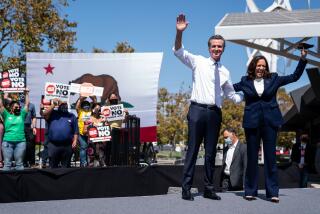Where did Obama’s ‘surge voters’ go?
- Share via
Remember the hordes of young people who were inspired by Barack Obama’s candidacy to vote for the first time in 2008? And then the supposition that they might change American politics forever? Well, don’t hold your breath.
At least in California, it turns out that a good many of them didn’t bother to go any farther down the ballot than the top line in 2008, and they didn’t show up at all in 2010.
That’s one of the findings of a new study by two enterprising researchers at the University of San Francisco, Corey Cook and David Latterman. (Full disclosure: I work at UC Berkeley’s Institute of Governmental Studies, which published the study in its online journal, the California Journal of Politics and Policy.)
COMMENTARY AND ANALYSIS: Presidential Election 2012
By looking at voting records, Cook and Latterman identified folks who cast a ballot for the first time in 2008 and compared them to other voters. They dissected the characteristics and voting behavior of the 2008 first-timers, whom they call “surge voters,” in recognition of the “Obama surge” in registration and turnout.
First, we should give Obama his due: 2.1 million Californians voted for the first time in 2008, a remarkable testament to the inspirational capacity of a historic candidate.
Unsurprisingly, those first-time voters tended to be young, ethnically diverse and urban. They were also more likely than most voters to be Democrats, although even more pronounced was their tendency to be “decline to state” voters, California-speak for independents.
They were not, however, uniformly liberal. Yes, they helped Obama deliver a wallop to John McCain — the Democrat carried California by 24 percentage points, the largest margin since FDR — but on other issues these voters were not far off from California’s traditional voting patterns, which is to say neither devoutly left or right.
Cook and Latterman examined three 2008 ballot measures — two bond issues and a measure requiring parental notification for abortion — and compared the results to similar measures that had been on the ballot in previous elections. It turns out that the 2008 Obama-inspired electorate produced results similar to those of past years.
The results were especially interesting on the abortion measure. There were plenty of Assembly districts with lots of “surge voters” that also had a lot of people voting in favor of the abortion restrictions, evidence that many of the Obama voters were just that — voters more dedicated to the candidate than his liberal causes.
This is typical of a broader trend in California elections. For the last 15 years, voters have almost invariably elected Democrats in statewide races, but their track record on ballot measures is far more ideologically mixed. Perhaps most famously, voters rejected same-sex marriage in 2008, but in the last 10 years they have also defeated more or less liberal ballot measures on taxes, environmental issues and public financing of campaigns.
So what can we expect from all those new Obama “surge voters” in the future?
Well, if you expect them to produce some sort of wave of change for decades to come, the evidence isn’t encouraging.
In 2008, the drop-off between presidential voting and down-ticket races, like congressional and legislative seats, was higher than it had been in 2004. It’s impossible to know how much of the ballot any individual voter filled out, but many of the new voters probably checked the box for Obama and flew the voting coop, the rest of the ballot be damned.
That help explains why, in a year when the electorate looked remarkably different, not a single congressional or state legislative seat changed party hands. (Gerrymandered districts also played a role.) So even if the Obama voters return to the polls in 2012, they may not fill out enough of the ballot to make much difference.
Or they may just not show up at all. That’s what most of them did in 2010. Just 42% of the first-timers from 2008 came back to the polls two years later to vote in California’s high-profile gubernatorial election.
What’s more, those who did show up in 2010 were hardly a uniform set of Obama true believers. Many of them were older white Republicans from rural areas. Call that the”tea party” surge.
It’s possible that this fall, a lot of the Obama voters who first turned out in 2008 will be lured back to the polls because their hero is once again on the ballot. But at least for the voters studied by Cook and Latterman, that won’t make much of a difference either because there is no doubt that the president will carry California easily.
If the voters inspired by Obama are truly to make much of a difference, they will have to develop a more reliable track record of completing a simple task: show up, vote the whole ballot, then do it again election after election.
Ethan Rarick is the director of the Robert T. Matsui Center for Politics and Public Service at UC Berkeley and the editor of “California Votes: The 2010 Governor’s Race.”
More to Read
A cure for the common opinion
Get thought-provoking perspectives with our weekly newsletter.
You may occasionally receive promotional content from the Los Angeles Times.









